Overview
Led by Dr. Kamy Sepehrnoori, the objectives of this research group include the development, testing, verification, and application of reservoir simulators for oil and gas recovery processes. The reservoir simulators developed by this research group are used as test beds for new process physics, computational algorithms, physical property models, and other scientific purposes. Our most recent code developments have been concentrated on the design and implementation of a multi-purpose suit of compositional reservoir simulators called the Multi-Purpose Simulator (MPS). This code is intended for the simulation of miscible gas flooding, chemical flooding, and simulating production form unconventional reservoirs. Other ongoing projects include model developments for wettability alteration, geomechanics, unstructured gridding, naturally fractured reservoirs, and compositional fluid flow in reservoir and wellbores including flow assurance issues such as asphaltene and scales precipitation and deposition. For the last several years, a great effort has been concentrated on simulation of unconventional reservoirs and development of embedded discrete fracture modeling (EDFM). We address the application of our codes as well as the commercial reservoir simulators for solving field simulation studies.
Annual Meeting
The RS-JIP meeting takes place yearly on the last Thursday and Friday of February.
Projects
Development And Maintenance Of Simulators For EOR Processes
An Equation of State Compositional Miscible Gas Flooding Simulator (UTCOMPRS)
The main tasks in this project are to maintain and expand the capability of our compositional equation-of-state reservoir simulator (UTCOMPRS). The ongoing research will focus on:
- Extension of gridding techniques for mapping complex geologic features such as fractures and faults for not only Cartesian grids, but also corner-point and unstructured grids.
- Development and implementation Advanced time discretization schemes and solution algorithms such as fully implicit and adaptive implicit.
- Extension of UTCOMPRS technology to a high performance environment through the use of our parallel processing framework.
- Development of a parallel linear solver designed for adaptive implicit schemes.
- Development on geomechanics modelling.
EXAMPLES
Cartesian Grid
This example case considers gas injection in a half a million active cells reservoir. Three hydrocarbon components and water are considered. Forty-nine vertical wells are considered. Cartesian grids are considered for this case.

Unstructured Grid
This example considers a gas flooding in an irregular shaped reservoir discretized using unstructured grids. Six hydrocarbon components and water are considered. Seven wells were considered and a third order TVD scheme was used.
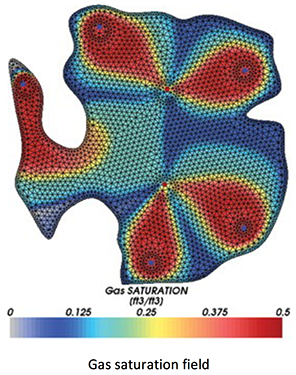
Corner-Point Grid
This example considers a waterflooding in an irregular shaped reservoir naturally fractured discretized using corner-point grids. Hundred-twenty-eight fractures are discretized using EDFM.

UTCOMPRS Resources
Memory peak usage for each approach implemented considering different number of hydrocarbon components.

UTCOMPRS is available for Windows and Linux platforms.
Chemical Flooding Reservoir Simulator (UTCHEMRS)
The main tasks in this project are to maintain and expand the capability of our chemical flooding reservoir simulator (UTCHEMRS). The ongoing research will focus on:
- Implement an efficient framework for unstructured grids.
- Extension of gridding techniques for mapping complex geologic features such as fractures and faults for not only Cartesian grids, but also corner-point and unstructured grids.
- Development and implementation Advanced time discretization schemes and solution algorithms such as fully implicit and adaptive implicit.
- Extension of UTCHEMRS technology to a high-performance environment through the use of our parallel processing framework.
- Development of a parallel linear solver designed for adaptive implicit schemes.
- Optimize memory usage through a lean memory management.
EXAMPLES
Cartesian grid
This example case considers Surfactant-Polymer flooding in an eight hundred thousand active cells reservoir (3.2 million total cells). Five components are considered: water, oil, surfactant, polymer, and salt. Twenty-seven vertical wells are considered. The run uses our adaptive implicit method for Cartesian grids.

Corner point grid
This example case considers Surfactant-Polymer flooding with horizontal wells in a 244,521 active cells reservoir (450 thousand total cells). Five components are considered: water, oil, surfactant, polymer, and salt. Two sets of horizontal wells, each with three injectors and four producers are considered. The run uses our adaptive implicit method for Corner-Point Grids. The geological model from the Johansen public data set is used (https://www.sintef.no/projectweb/matmora/downloads/johansen/)

UTCHEMRS Resources
Memory peak usage for each approach implemented considering different number of components.
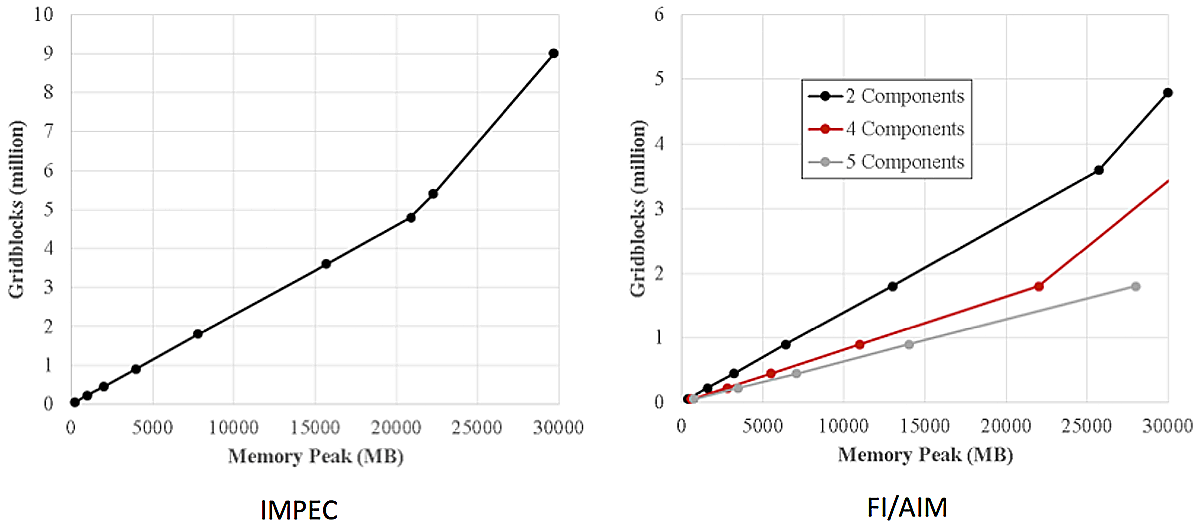
Parallel and Multi-Purpose Simulator (MPS) Frameworks
In the following we present the framework for high performance parallel processing and the design for our new simulator: MPS.
Framework for Parallel Reservoir Simulation
Parallel reservoir simulators provide several advantages over non-parallel reservoir simulators, such as
- Capability to run bigger models.
- Capability to have simulation results faster by using several processing units at once.
- Not limited to single computer memory. Memory available increases as more computers are used.
However, the creation of a parallel reservoir simulator is a more complex task than non-parallel simulators. Problems related to parallel implementation such as parallel communication, model division among processors, and the management of data distributed among processors, among others should be addressed and solved on top of the already complex task of simulator development. Hence, development of parallel reservoir simulators is more time intensive than the traditional development on single processor computers.
The objective of this project is to develop a framework to aid the development of parallel reservoir simulators. This framework implements and handles the parallel complexity and provides easy-to-use programming interfaces to accelerate the development of new parallel reservoir simulators or the parallelization of existing ones.
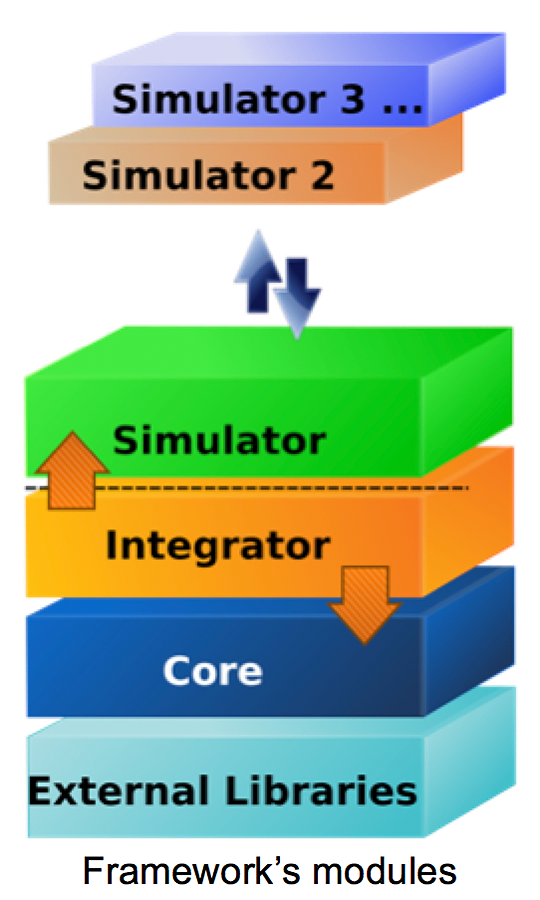
Framework’s current capabilities are:
- Flexible and extensible input data processing using the Lua scripting language.
- Parallel reading of spatial distributed properties.
- Use of Recursive Coordinate Bisection (RCB) algorithm for domain decomposition that takes into account inactive cells.
- Support for multiple output formats for visualization.
- Modularized design allows future modification.
The University of Texas Compositional Simulator (UTCOMP) was used in conjunction with the framework to create a parallel reservoir simulator. Reservoir models with up to half a billion grid cells has been executed with this simulator.
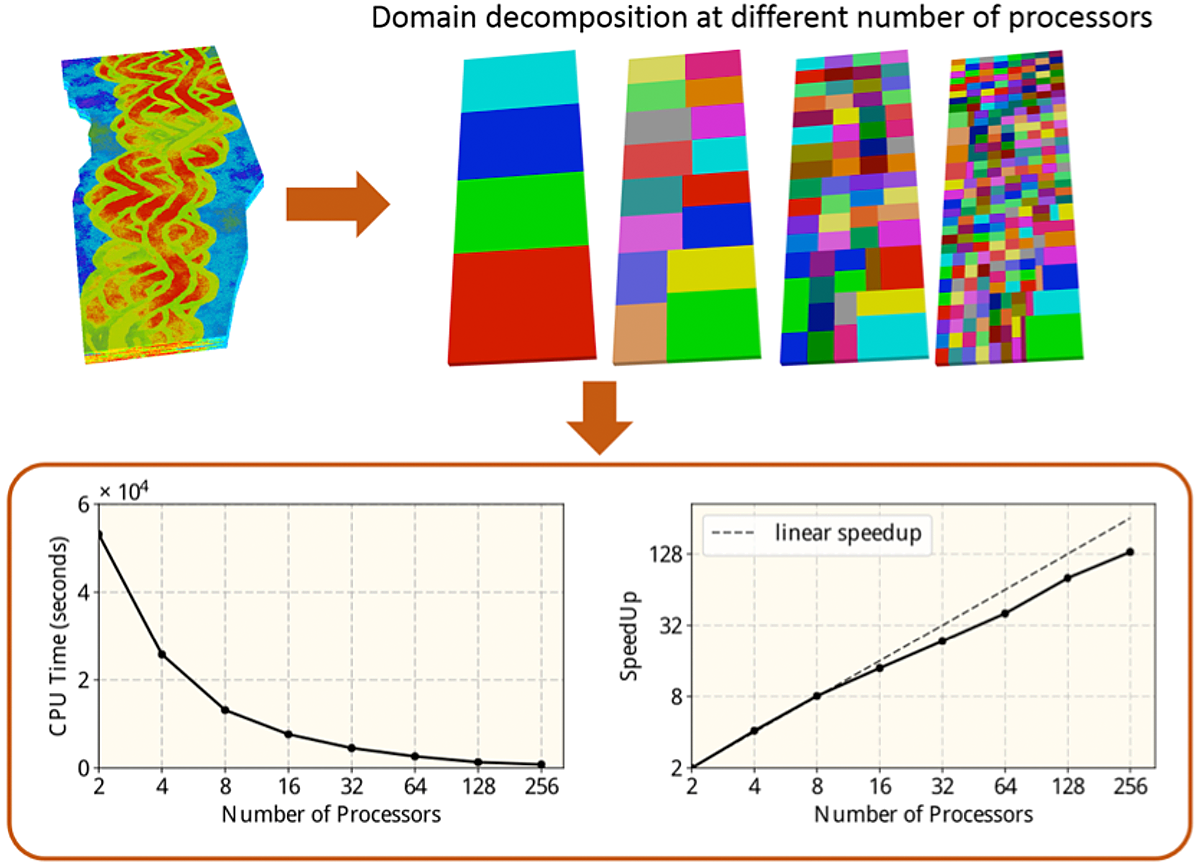
Multi-Purpose Simulator Framework
This project consists of development of a framework for multi-purpose reservoir simulation with the following capabilities:
- Receive input from multiple parties.
- Modular and easy to include new functionality.
- Parallel computation is separated from physical modules.
When fully developed, the framework will have the capability of simulating various processes for production form conventional and unconventional reservoirs.

Unconventional Reservoir Modeling And Simulation
A New Upscaling Method for Flow Simulation of Fractured Systems with EDFM
Background: Flow simulation for fractured porous media is highly important since nearly 60% of hydrocarbon reserves are in fractured reservoirs. Though fine scale fracture modeling has been developed to capture flow behaviors associated with fractures, it requires too many extra fracture grids for geological formations with numerous number of natural fractures. Upscaling methods could be used to generate reduced models for efficient flow simulation.
Objective: The objective of this study is to develop a system of upscaling methods to generate efficient reduced order models for different reservoir conditions.
Approach: We developed an upscaling framework to finish model reduction based on the fine scale models for reservoirs with different fracture patterns, well configurations, and matrix conditions. First, an effective partitioning algorithm is introduced to preserve the effects of fracture and, at the same time, to reduce the number of fracture grids used for coarse scale simulation. In addition, a time-stepping method is proposed to deal with the flow systems without sources (an example is the reservoir model with no-flow boundaries and without injection wells). Besides, the time-stepping method can largely reduce the linear solver steps (and thus time) for upscaling procedures, especially for the fractured systems compared with conditional steady state methods.
Application: Efficiency and accuracy of the new upscaling method were both verified by different numerical tests with three-phase flow (speedups of three orders of magnitude were achieved in some cases with less than 5% error in production and pressure profiles).

Figure 1. 2D reservoir model (left) and parameters (right) of a numerical test.

Figure 2. (a) Oil prodcution results of 20 years’ production of different scales of coarse models. (b) Relative pressure error of scale of "28x28" after 5 years’ production.

Figure 3. Upscaling preprocessor for the EDFM method
An Automated History-Matching Approach To Assess The Effect Of Natural Fractures In Unconventional Reservoirs Using An Embedded Discrete Fracture Model And CMOST
Background: Natural fractures are thought to play an important role in production from unconventional reservoirs because production has been historically larger than the expectations. However, it is not yet fully understood how the existing natural fracture networks contribute to overall permeability of an unconventional reservoir after a hydraulic fracture treatment. We examine this fluid flow problem using reservoir simulation approaches. Unconventional reservoirs typically exhibit large uncertainty in rock and fracture properties making manual history matching a challenging endeavor. Computer-assisted history matching methods are preferred because they generate sets of non-unique geological realizations, based upon which, probabilistic production forecasts are obtained.
Objective: The objective is to evaluate the effect of the presence of natural fractures on the induced-fractures geometry and the effective permeability of the stimulated rock volume (SRV) and to assess the contribution of natural fractures to the estimated ultimate recovery (EUR). This can be done by comparing the history-matching end results for a reservoir model, with both induced and natural fractures included, to those for a simpler model with induced fractures only.
Approach: We develop and apply a novel workflow that integrates embedded discrete fracture model (EDFM) into the existing functionalities of the commercial optimization tool, CMOST. This approach involves four main steps: (1) Initializing parameters for an experiment by CMOST (2) Running a pre-simulation command that calls an in-house EDFM preprocessor and generates an updated model, (3) Running the model on an appropriate simulator, and (4) Calculating the objective function. We apply this method to perform history matching for a horizontal tight oil well in the middle Bakken. We further repeat history matching for the same model after including a set of 1,000 randomly distributed natural fractures. We take advantage of EDFM to create multiple representations of fracture networks without restructuring the whole grid. In both studies, four parameters are set to vary within predefined continuous ranges.
Applications: Fig. 1 shows a schematic of the different fracture geometry and SRV permeability obtained after including natural fractures. The difference between the EUR of the two scenarios is indicative of the contribution of natural fractures to production. If that difference is not significant, we will have support that a simple planar fracture model combined with SRV is good enough for production forecast. However, it will remain for future work to experiment with different reservoir types and fracture intensities. Compared to a previous study that was based on an LGR model, this new method results in a better match to the field-recorded bottom-hole pressure data. Moreover, this method can be implemented in a similar fashion for performing sensitivity or optimization studies and can be extended to alternative optimization engines.
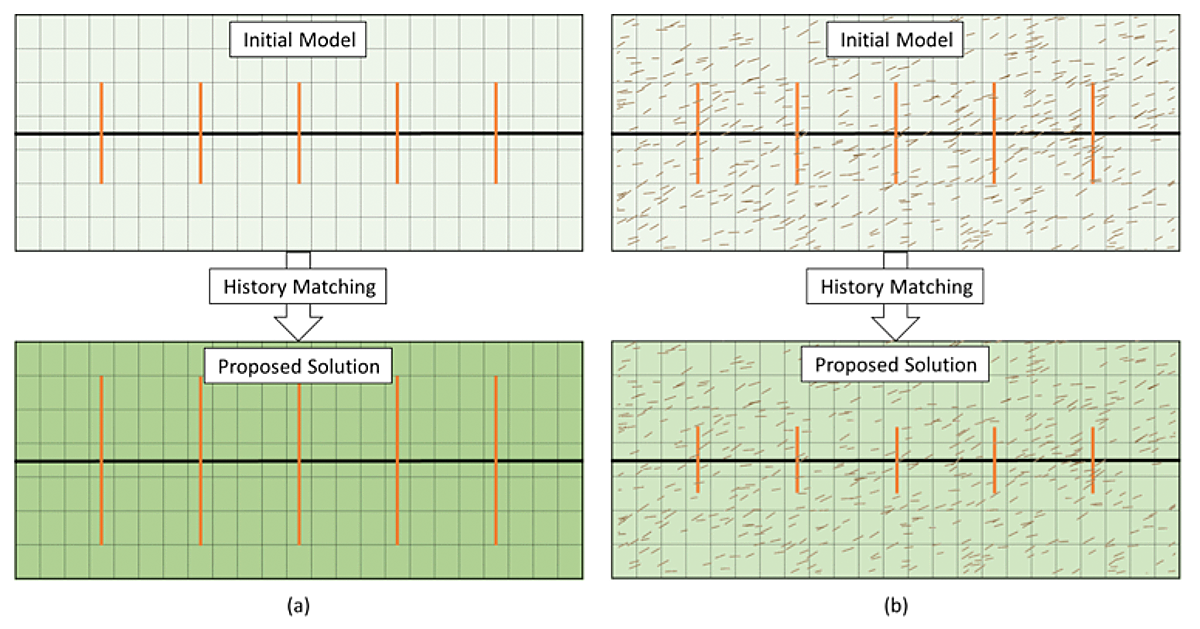
Figure 1. Schematic models of a horizontal well with planar induced fractures (represented by vertical orange lines). A darker color indicates larger permeability of a grid block. Production history–matching solutions are obtained for one model without natural fractures (a) and the same model after including natural fractures (b).

Figure 2. Bottom-hole pressure, history-matching results (left) and comparison between production forecasts of the two scenarios (right).
Application Of EDFM In Unconventional EOR In An Eagle Ford Gas-Condensate Field
As the pressure drops below dew point in an unconventional gas-condensate reservoir, the liquid drops out of gas phase and forms an oil phase in matrix and fracture. The volume of oil phase formed in the matrix mostly stays below the residual oil saturation, i.e., the oil will be trapped in matrix permanently if enhanced oil recovery techniques are not applied. The gas huff-n-puff process has been performed and shown the potential of improving the recovery from tight oil reservoirs. Recently, a huff-n-puff EOR project has been performed for the first time in a gas-condensate field in the Eagle Ford shale play. The studied section of the field contains 13 horizontal producers. The wells have been producing for 3 to 7 years and the oil production rate of each well has declined below 10 barrels per day. The sector was selected as a potential candidate for performing gas huff-n-puff to enhance the oil recovery.
The objective of the study was to investigate the feasibility of huff-n-puff EOR in the gas-condensate part of the field. Compositional reservoir simulation was used to predict the performance of enhanced oil recovery. A sector model was built for the area selected as the prospective candidate for gas injection. The embedded discrete fracture model (EDFM) was used for modeling the fractures, improving the CPU time by an order of magnitude compared to the local grid refinement. A Peng-Robinson equation-of-state model was prepared based on the early produced samples from the wells. The only available gas for injection was the produced gas from the surrounding producers. A thorough phase behavior analysis was conducted to understand the miscibility of the injected gas and the in-situ fluid.
The well interference through fracture hits play an important role in the studied reservoir. The image logs from the surrounding wells show the abundance and extent of the long fractures connecting multi producers. The long fractures can impede the pressure buildup during gas injection and hamper the gas huff-n-puff performance. Several long fractures were added to the reservoir model to capture the characteristics of well interference. Figure 1 shows the sector model containing all 13 wells, corresponding hydraulic fractures, and long connecting fractures. Figure 2 shows the pressure distribution of the history matched model before the start of gas injection.
Several scenarios were tested using the tuned model to find out the optimum injection and production strategy. The amount of injected gas per cycle, the period between two injections, the best well candidates for injection, and the length of shut in time were among the various parameters that were investigated in this study. The simulation results show that the gas huff-n-puff can increase the oil recovery by 20% after 10 cycles of gas injection. The results of field operation have been in agreement with the simulation forecasts after one cycle of gas injection and production.

Figure 1. The schematic of sector model containing 13 wells, hydraulic fractures, and long connecting fracture.
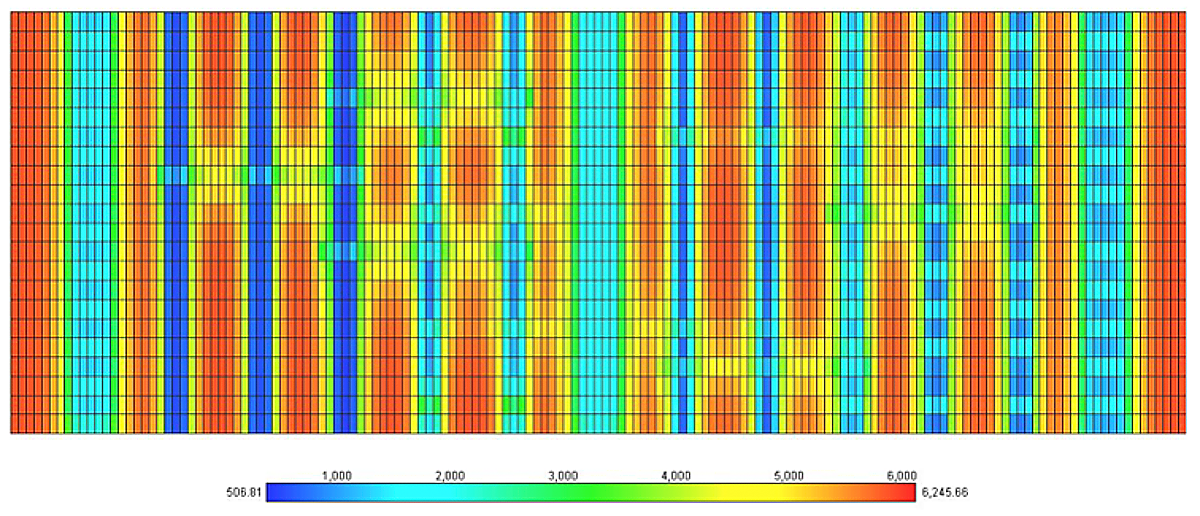
Figure 2. Pressure distribution of the history matched model before the gas injection.
Automatic History Matching Workflow Coupling Multiply Proxy-Based MCMC And EDFM For Shale Gas/Shale Oil Reservoirs
Background: A manual history matching is a time-consuming process and too risky for an investment decision because it cannot capture the uncertainty of subsurface information and production forecast. Especially in shale gas/shale oil reservoir, the uncertainty of fracture geometry and reservoir properties should be captured.
Objective: The objective of this study is to retrieve an unbiased multiple history-matched solutions and posterior distribution of fractures and reservoir properties in shale gas/shale oil wells.
Approach: We developed a practical and efficient iterative assisted history matching (AHM) workflow by coupling the benefits of using multiple objective function, multiple proxy-based MCMC algorithm, EDFM and commercial reservoir simulator (CMG). Complex hydraulic fractures and natural fractures can be considered using the EDFM technology.
Applications: We performed automatic history matching using our workflow in different shale gas and shale oil reservoirs such as Marcellus shale, Bakken, Eagle Ford, and Permian Basin. We obtained multiple realizations of history-matched solutions and posterior distribution of fractures and reservoir parameters for each well, which can be compared among each formation. These multiple history-matched solutions can be used further for probabilistic production forecast and future activities planning and optimization.
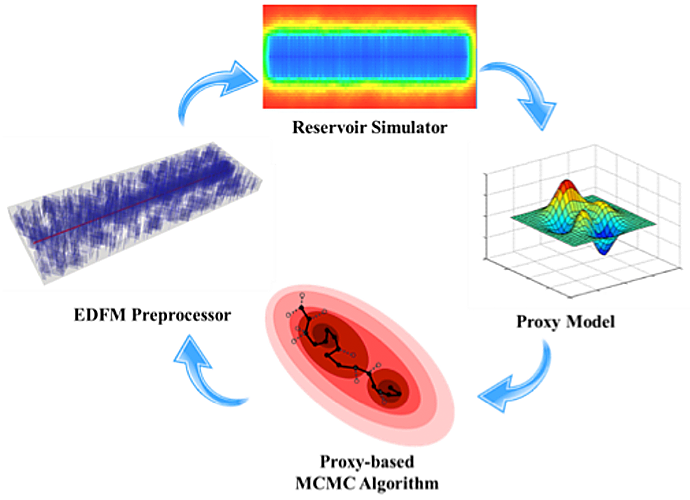
Assisted History Matching (AHM) Workflow
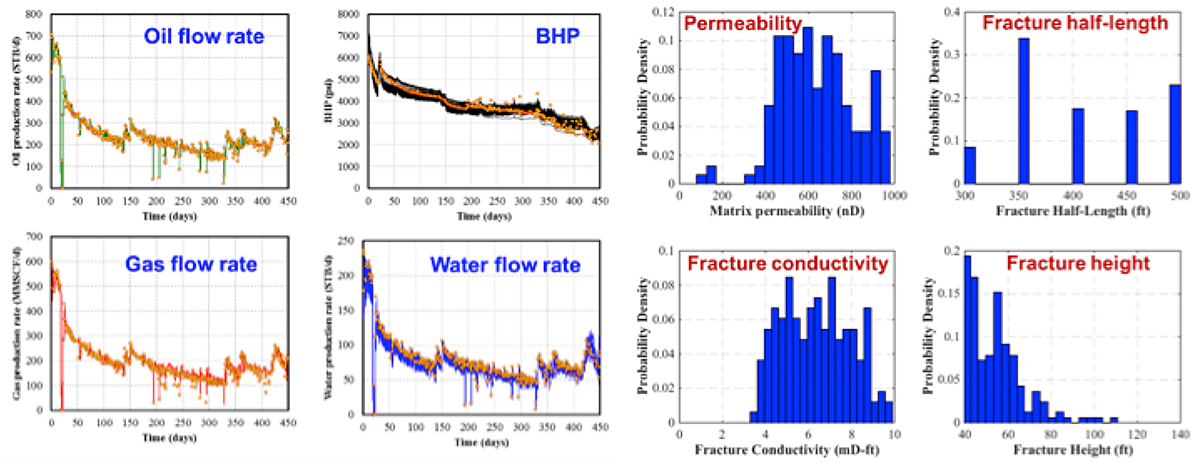
Multiple Realizations of History-Matched Solutions and Posterior Distribution of Uncertain Matrix and Fracture Parameters
Development And Application Of A Coupled Flow-Geomechanics Simulator In Unconventional Reservoirs With Complex Fracture Networks
Background: Stress evolution along with hydrocarbon production in highly fractured reservoirs has become a great focus in unconventional field. However, most coupled simulators are limited to reservoirs with very simple fracture networks. Coupled modeling between fluid flow and geomechanics with complex fracture networks remains an impediment in this regard.
Objective: The objective of this study is to develop a coupled flow-geomechanics simulator which incorporates not only porosity change but also fracture conductivity variation, and to apply it to formations with complex fracture networks for better infill drilling and refracturing design.
Approach: A comprehensive numerical model of the coupled flow and geomechanics simulation is developed with UTCOMP-EDFM modeling the multiphase flow and FEMDEM approximating the geomechanics. The equation system is firstly solved using one-way coupling method to demonstrate the importance of considering fracture geomechanics. Then two-way coupling method is applied to realize more accurate prediction of the stress field evolution for unconventional reservoirs with complex fracture networks, such as nonplanar hydraulic fractures intersecting with a large amount of natural fractures.
Applications: Based on production and mechanics data from oilfield, we can apply our coupled flow-geomechanics simulator to get a quick prediction of the stress field at any production time for different production scenarios such as natural depletion, water flooding, or CO2 injection. The generated stress field distribution will provide us with an intuitive cognition of where to place a new well and how to proceed new fracturing.
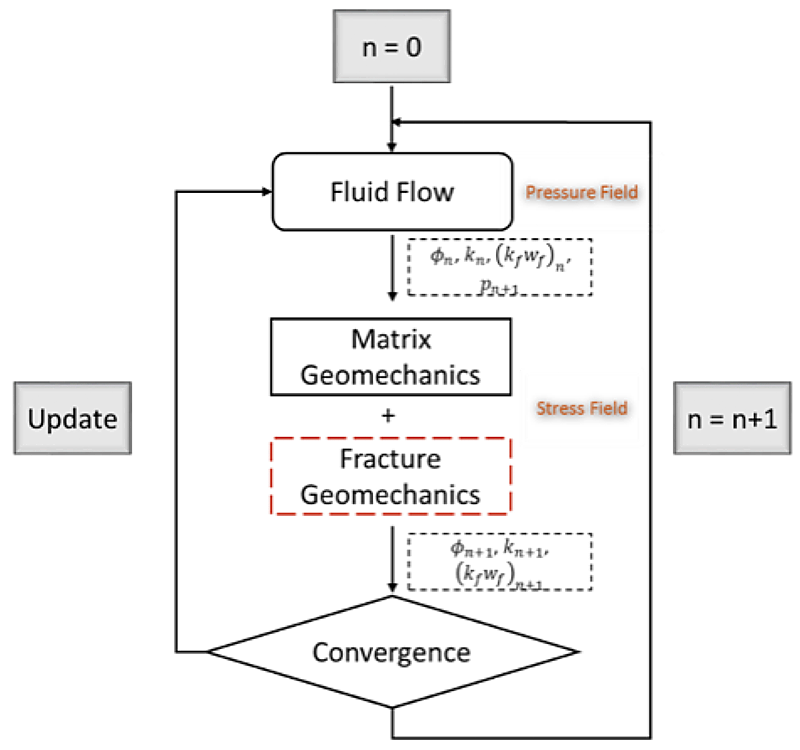
Flow chart of coupled flow-geomechanics modeling

Pressure and stress distribution of complex fracture geometries
Field Application Of EDFM In Simulating Pressure Response Of Well Interference With Complex Fracture Hits
Background: The effect of well interference through complex fracture hits in shale reservoirs needs to be investigated. Although numerous pressure tests have proved the existence of well interference, relatively few physical models exist to quantitatively simulate the pressure response of well interference.
Objective: The objective of this study is to identify and analyze the mechanisms behind inter-well interference, evaluate its effect on well performance and well spacing optimization.
Approach: We developed a numerical compositional model in combination with a fast embedded-discrete-fracture-model (EDFM) method to simulate well interference. The EDFM can be applied in conjunction with CMG or ECLISPE. Through nonneighboring connections (NNCs), the fast EDFM method can easily and properly handle complex-fracture geometries, such as nonplanar hydraulic fractures and a large amount of natural fractures.
Applications: Using data from field interference tests such as Eagle Ford where one well is producing and the other wells are shut-in, we apply the numerical reservoir model to match the observed pressure change of the shut-in wells and actual production data of the production well and explore the effects of variations in the physical parameters that control the mechanisms of well interference.

Well interference due to complex fracture hits and pressure distribution
Flow Profiling And Fracture Characterization With Distributed Temperature Sensing (DTS) And EDFM
Background: Flow profiling and fracture characterization are crucial to understand the performance of the hydraulic fracturing operation. DTS is an enabling technology for fracture diagnosis. However, few models can handle the quantitative analysis of DTS data. The business value of DTS data is not fully utilized by the current commercial software.
Objective: Optimize unconventional reservoir development such as fracture spacing, effectiveness of staged fracturing. Evaluate fracture properties, geometry and multiphase flow measurement. Ultimately, our model and analysis approach will be beneficial to the decision-making process in shale or tight reservoir.
Approach: The analysis of DTS data includes the development of forward model and inverse model. For forward model, we developed a numerical compositional model which couples the reservoir and wellbore. The EDFM is applied to efficiently handle complex fractures. For the inverse model, an automatic history matching tool (Ensemble smoother with multiple data assimilations) is developed to perform flow profiling and fracture characterization with our forward model.
Applications: With our approach, the fracture geometry and property can be characterized for each fracture. Basically, the DTS data analysis provide a higher resolution fracture evaluation and characterization compared to production and pressure history matching. The characterization can be zoomed in to each single fracture.

Field DTS Data and Our Forward Model Results
Modeling Enhanced Oil Recovery (EOR) In Unconventional Oil Reservoirs Using EDFM
Background: Shale formation has been one of the main sources of oil in the United States. However, the average oil recovery factor from the oil productions in shale reservoirs, roughly under 10% of oil originally in place (OOIP), are significantly low, compared with that of conventional reservoirs. This offers opportunities for the application of conventional reservoir’s successfully implemented enhanced oil recovery (EOR) methods in shale reservoirs. Due to the significant differences in their characteristics, the most effective and efficient modifications to those EOR methods should be formulated in order to accommodate those differences and to be able to increase the oil recovery factor of oil production in shale reservoirs from what it is currently.
Objective: The objective of this study is to identify and analyze the mechanisms behind EOR processes in shale, evaluate their effects on oil recovery, formulate the production optimization strategies by taking into account the EOR processes, and create useful criteria, guidelines, and rule of thumbs related to EOR application in shale reservoirs.
Approach: We developed various numerical reservoir models in combination with related reliable methods, such as, embedded-discrete-fracture-model (EDFM) to simulate EOR processes in shale reservoirs with various characteristics.
Applications: Using data from field production such as Eagle Ford, we apply the numerical reservoir model to observe the responses of those models to various EOR methods in order to understand the EOR processes behaviors, to identify EOR methods limitations, and to synthesize the best optimization strategies.
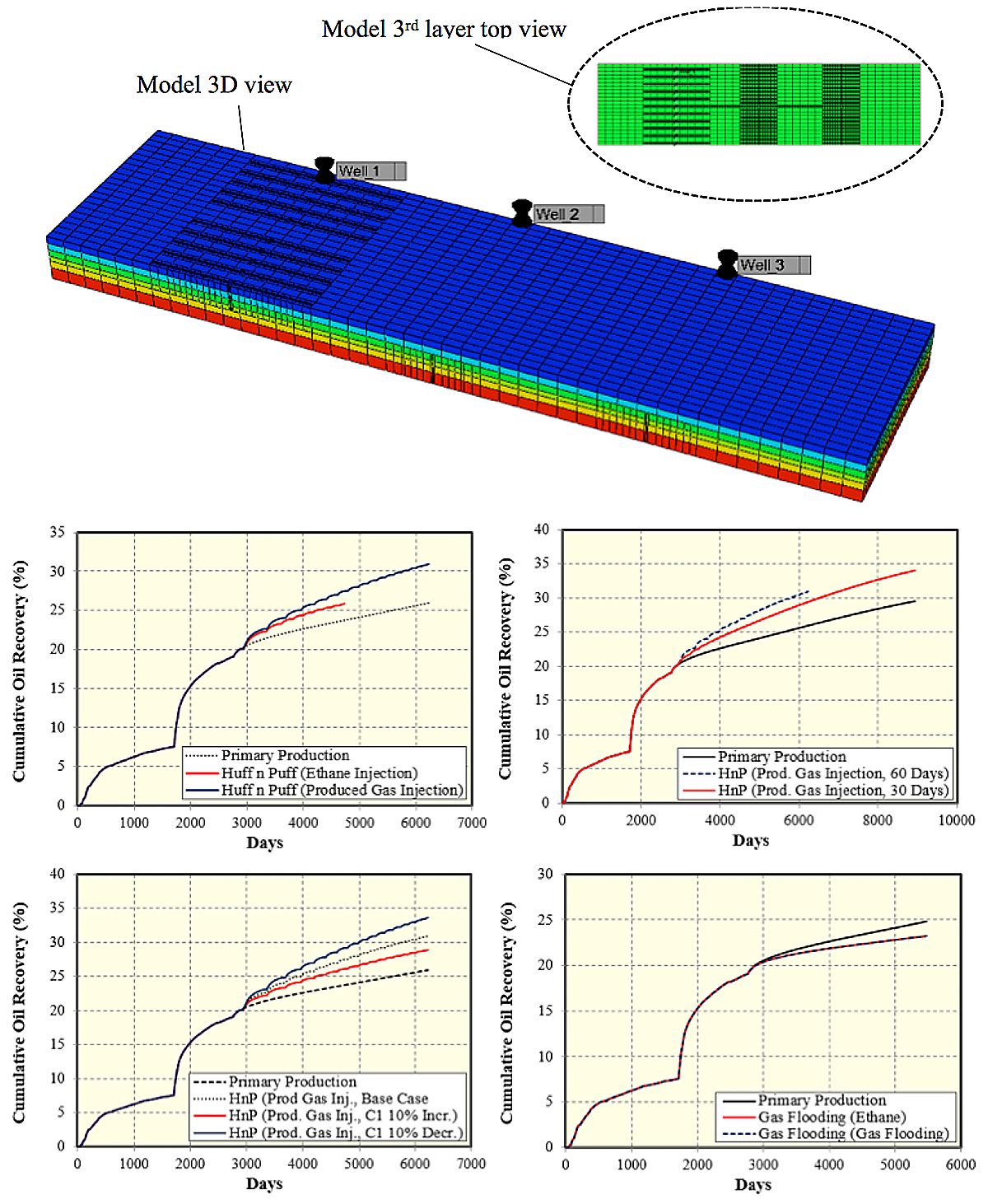
Cumulative oil recovery factors for various EOR strategies
Modeling Inter-Well Fracture Interference And Huff-N-Puff Pressure Containment In Eagle Ford Using EDFM
Background: Optimizing spacing of infill wells and fractures can lead to large rewards for shale field operators, as well as proper pressure containment during the development of the field. Although several studies have been employed to show the existence of well interference, few models have also implemented Huff-n-Puff and water injection to optimize further hydraulic fracture designs and pressure containment.
Objective: The objective of this study is to investigate the impact of well interference through connecting fractures by multi-well history matching, and to propose profitable opportunities for Huff-n-Puff application during the development of the field.
Approach: We present an application of compositional reservoir simulator in conjunction with EDFM to simulate inter-well fractures interference and Huff-n-Puff field application. Through nonneighboring connections (NNCs), the EDFM method can handle complex-fracture geometries, such as nonplanar hydraulic fractures, faster than conventional LGR methods. For this work, updated production and wellbore image logging data from Eagle Ford was used to construct a model to perform nine wells sector model history matching. Later, inter-well connecting fractures were included based on wellbore logs correlation. Finally, Huff-n-Puff implementation is modeled considering inter-well interference and multi-point water injection to mimic pressure barriers.
Applications: This study has performed rigorous workflow for estimating the impacts of spatial variations in fracture conductivity and complexity on fracture geometries of inter-well interference in Eagle Ford. The present model workflow will be applied for further long inter-well fractures Huff-n-Puff modeling in other areas of the reservoir by the operator of the field.

Inter-well Fracture Interference and Huff-N-Puff Pressure Containment in Eagle Ford using EDFM
Near Term Projects: Advanced EDFM And Field Applications
In the following we present the descriptions of some of the ongoing projects concentrated on further developments EDFM.
Project Title: EDFM for Handling Irregular Fracture Geometries
We are developing an advanced EDFM method using polygon technology to handle any irregular fracture geometries. The EDFM can be applied in conjunction with in-house and commercial reservoir simulators. This feature has a strong capability to couple fracture model outputs. We will apply this technology in the field data analysis.

Complex fracture geometries with irregular boundaries and pressure distribution after simulation
Project Title: EDFM for Unstructured Gridding
We are developing an advanced EDFM method using unstructured technology to handle any complex fracture geometries. We will apply this technology in the field data analysis.

Project Title: NPV optimization of well spacing in Permian Basin with natural fractures
The profitability of unconventional reservoir depends heavily on the quality of reservoir, price of oil and gas, and the effectiveness of development, which are usually uncertain when we make the development plan. To reduce the risk and maximize the value, we carry out the study on the NPV analysis under those uncertainties. We retrieve part of the information about the properties of reservoir and the effectiveness of the completion from history matching. Then, we generate a batch of reservoir model base on the uncertainties. After that, we do the simulation with the candidate well placement plan and do the NPV analysis at different economic environment.
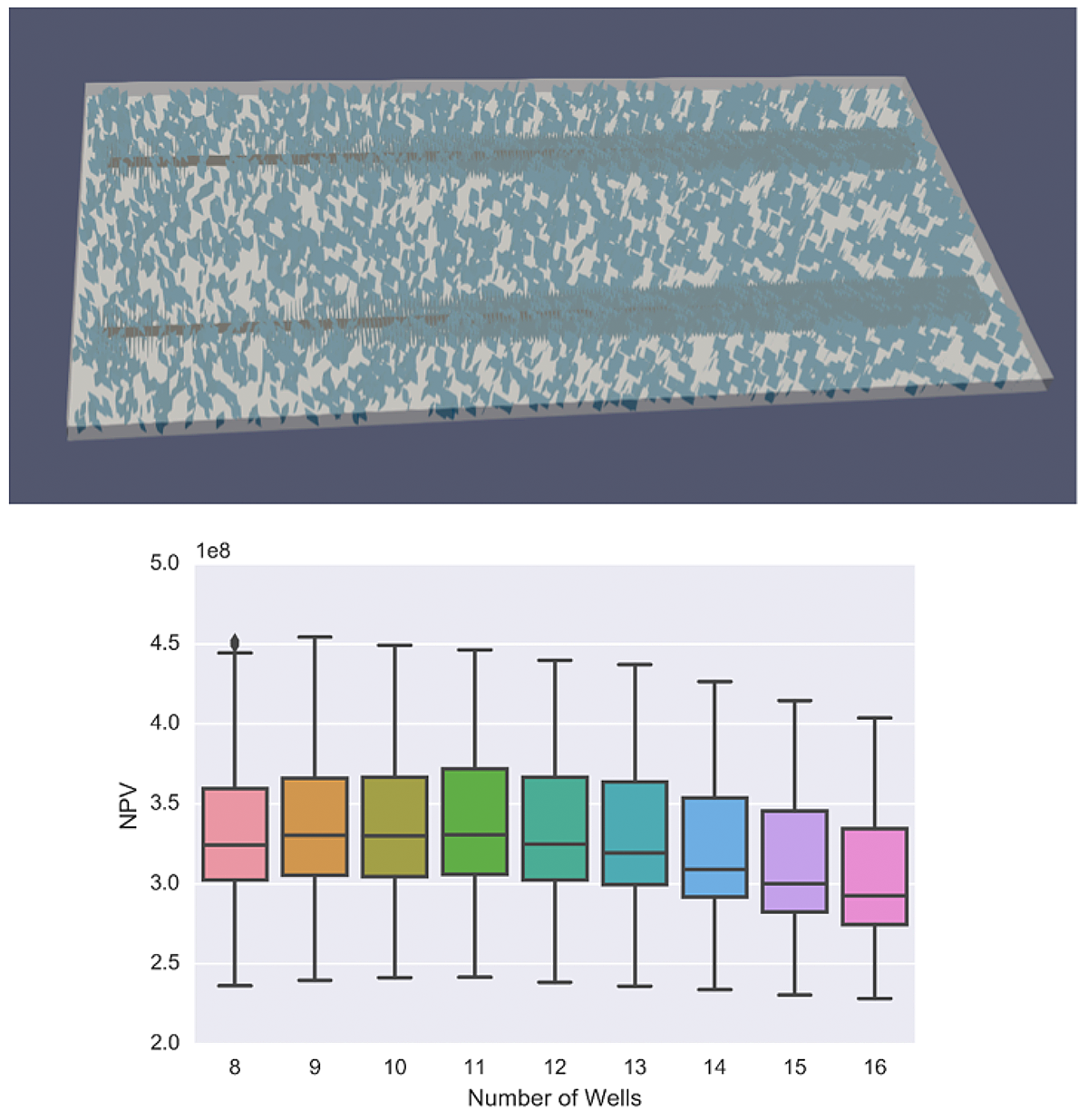
Project Title: Field Application of multi-stage hydraulic fracture modeling for unconventional reservoir development
Background: Multi-stage hydraulic fracture treatment is a key technology for unconventional reservoir development. The presence of rock fabrics is common and widespread in unconventional shale reservoirs, which make the fracture propagation process very complex. Generated complex fracture geometry greatly affect well performance and reservoir development.
Objective: The objective of this study is to apply multi-stage hydraulic fracture model to characterize complex fracture geometry and integrate it with a reservoir geomechanics model and a reservoir simulation model to optimize fracture treatments and reservoir development.
Approach: We have developed a complex hydraulic fracture propagation model, which can be used to simulate multiple fracture propagation in multiple wells with and without considering rock fabrics. The model couples rock deformation and fluid flow in the fractures and the horizontal wellbore.
Applications: Based on field treatment data of hydraulic fracturing, the model can generate complex fracture geometry and be applied for well performance prediction, well interference investigation, refracturing optimization, and optimization of parent-child well development.

Model Development (Ongoing And Previous Projects)
Compositional Wellbore
The production of hydrocarbons often involves a concurrent gas and liquid (oil/water) flow in the wellbore. As a multiphase/multicomponent gas-oil mixture flows from the reservoir to the surface, pressure, temperature, composition, and liquid holdup distributions are interrelated. However, most two-phase wellbore simulations are currently performed using "black oil" models. In this project, a compositional wellbore model is coupled with a reservoir simulator to compute pressure and temperature distribution. Compositions of liquid and gaseous phases in the wellbore are determined from two-phase flash calculations and taking into consideration the slip between phases. The temperature profile is calculated in the wellbore to give a more accurate liquid holdup and pressure drop.
The wellbore model is coupled to a reservoir simulator to calculate fluid-flow between reservoir and wellbore. The pressure and temperature distributions of the compositional model are compared to the black oil model. Although the input requirements and computing expenses are higher for compositional model compared to the black oil, the results show that in some cases, such as those involving highly-volatile oil and retrograde condensate gas, ignoring compositional effects may lead to errors in wellbore pressure profile. The model is then extended to allow for fluid flow in horizontal wellbores. The simulator is capable of modeling concurrent flow of gas, oil, and water in horizontal and vertical wellbores.

Conformance Control Using Microgels
Conformance control methods using polymer gel treatments have been widely used to reduce water production as well as improve sweep efficiency. Conformance control strategies include
- Bulk gels as a near wellbore treatment where high concentration of polymer and a cross linker is injected to form strong gels
- Colloidal dispersion gel (CDG) where polymer gels with colloidal dimensions are dispersed in water. Small concentration of polymer is injected with a cross linker such as aluminum citrate to form gel in situ or in some cases inject preformed CDGs
- Preformed particle gel (PPG) where mm-sized preformed gels are injected in the porous media and in the presence of water the PPG grains swell and provide the permeability reduction
The current version of UTCHEM has several polymer/crosslinker kinetics for bulk gel for near wellbore and in depth treatments. In this project, we are extending this capability to model in situ or preformed CDG and preformed particle gel (PPG) propagation in porous media.
Coupled Reservoir And Wellbore Simulator For Predicting Flow Assurance Problems
We have extensively worked on development and application of coupled reservoir-wellbore model to predict asphaltene and scale formation in the reservoir and wellbore. For the asphaltene module, both PC-SAFT and Peng-Robinson EOSs have been implemented to accurately predict the asphaltene phase behavior. Flocculation and deposition models are also integrated with the thermodynamic model to mimic the dynamics of asphaltene deposition in the reservoir and along the wellbore.
The prediction results of the developed tool are highly crucial to monitor the field performance, optimize the operating conditions of the field (injection gas/water composition), and propose the remediation technique.

Asphaltene Deposition in Wellbores

Schematic of the capabilities of developed flow assurance simulator
Low Frequency Electrical Heating For High Viscous Or Heavy Oil Reservoirs
The electrical low frequency heating is a thermal recovery process that has been proposed for high viscous and heavy oil reservoirs. In this process, the high viscous or heavy oil is heated by electrical energy to lower the viscosity; then production wells are opened or injection of chemical, hot water, or steam is started. In this thermal process, electrical current passes through reservoir fluids due to electrical conductivity of fluids. The flow of electrical current through reservoir leads to heating the reservoir and thereby reducing oil viscosity.
Reservoir rock and existing fluids are used as electrical resistance elements. In order for the electrical current to be able to flow through porous media and generate heat, one of the liquid phases should be continues and conductible. In this study, three basic equations of classical electricity and magnetism, developed by Maxwell in 1863, are simplified and assumed for low frequency to obtain conservation of electrical current equation and Ohm's law. Consequently, conservation of electrical current equation and Ohm's law are solved for the electric potential using numerical finite difference method in the UTCHEM simulator. The heating rate due to electrical current is calculated and then added to energy equation as source term for each grid block at each time step.

The conducting path for electrical current is through the continuous brine phase. Therefore, the water saturation and electrical conductivity of this phase have an important effect on the heating process. The reason is that the electrical conductivity of water phase is relatively high compared to rock, oil, and gas phases and this leads the electrical current density in water phase to be much more than other phases. Electrical conductivity of water phase can also be easily increased by injecting high saline water into the reservoir and increase heating substantially. This is highly beneficial and the main advantage of electrical heating mechanism is to obtain high recovery in comparison to other thermal recovery methods.

The efficiency of this process depends on heterogeneity, geological connectivity, solution gas and gas cap, bottom water zone or aquifer, initial water saturation and residual oil saturation during operation. It also depends on the amount of heat lost in overburden and upper burden as well as inside the reservoir, productivity, and thermal and electrical properties of fluids and rock.
Mechanistic Modeling Of Low Salinity Water Injection
Waterflooding as a secondary oil recovery method is still the most commonly used technique for fluid injection since 1865. Previously the main concern was the amount of water injection into the reservoir while recently researchers have figured out that the quality of the injected water is as important as the quantity and it should be monitored. This technology is known as low salinity water injection, LoSal, Smart Waterflood and Advanced Ion Management in the literature.
Evidence from laboratory studies, supported by several field tests, has distinctly shown that injecting low salinity water has a significant impact on oil recovery. Although there are many LoSal experimental results reported in the literature, the publication on modeling of this process is scarce. However, practical application of IOR processes requires a predictive model.
Since mechanistic modeling, for the low salinity water injection, is not seen in the literature, in this project, we investigate a mechanistic modeling approach for the low salinity water injection. We believe no matter the manner and details of mechanism, it ought to be all about ions. The key objective in this project is to link the water-rock chemistry to changes in the state of a rock. For example, if the dominant mechanism for low salinity water injection is the wettability alteration, it will be viewed as follows in this project:
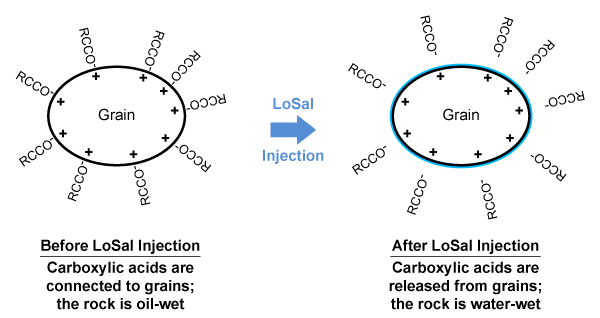
Since geochemical reactions are the basis for this mechanistic modeling, to properly model LoSal, we would need a geochemical engine to handle geochemical reactions in the reservoir. Toward this goal we are coupling IPhreeqc, available in USGS geochemical module, with UTCHEM, The University of Texas’s in-house chemical flooding simulator.
Modeling The Combined Effect Of Injecting Low Salinity Water And Carbon Dioxide On Recovery From Hydrocarbon Reservoirs
Carbonate rocks account for more than half the world's hydrocarbon proven reserves. Oil recovery from these reservoirs is a challenge due to their complex nature. Several enhanced oil recovery techniques have been proposed for improving the oil recovery from carbonate reservoirs. One of the emerging improved oil recovery (IOR) techniques for wettability alteration in carbonate reservoirs is low salinity water injection (LSWI). The popularity of this technique is because of the simplicity of the process compared to other EOR processes. Another commonly used and favorable EOR technique especially when a gas source is available along with high API crude oil and low permeability formations as in carbonates is Carbon Dioxide (CO2) injection. Several studies have been conducted on LSWI at laboratory-scale and to a limited extent at field-scale. Most studies have confirmed a positive response to low salinity injection, which is translated into additional oil recovery in both secondary and tertiary injection modes. Wettability alteration is believed to be the main mechanism underlying additional oil recovery due to LSWI; however, some other mechanisms were suggested such as dissolution processes.
Few LSWI modeling studies have been performed so far especially on carbonate rocks compared to sandstone rocks. Some of the reasons for this reluctance are the lack of clay, the complex chemical interactions between COBR, the heterogeneity of carbonate rocks, and the discrepancy in some of the published results in the literature. Therefore, we propose a LSWI model for oil recovery prediction using the UTCHEM simulator and even move a step further by modeling the effect of combining CO2 and LSWI on oil recovery using the UTCOMP simulator. The modeling work is conducted by shifting the relative permeability curves and altering the residual oil saturation.
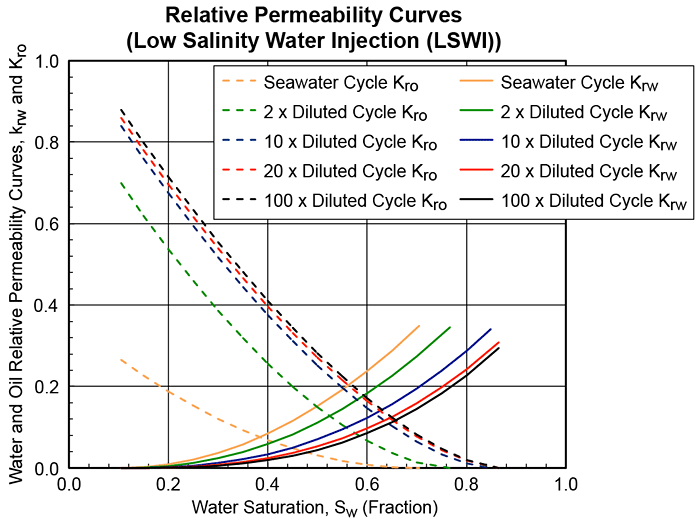
Reservoir Souring
Reservoir souring is an increase in hydrogen sulfide concentration during water injection operations. H2S content reduces the value of produced hydrocarbon, in addition to being a health and safety issue. Nitrate injection is an effective method to prevent the formation of H2S. This project includes the modeling and simulation of biological reactions associated with reservoir souring and nitrate injection for remediation. The model is implemented in GPAS.
There are proposed mechanisms that describe the effect of nitrate injection on souring in the reservoir. Depending on the circumstances, more than one mechanism may be involved. For each mechanism, we specify the biological species and chemical components and determine the role of each component in the biological reaction. For every biological reaction a set of ordinary differential equations are solved along with the mass conservation equations for the transport of chemical and biological species.
Biological reactions occur in the mixing zone developed between injection and formation water. Dispersion can have a significant effect on the development of the mixing zone in the reservoir. To study this effect, a dispersion term is implemented in the species mass balance equations. This term consists of molecular diffusion and mechanical dispersion. The biological model can predict the onset of souring and the effectiveness of nitrate injection in remediating the souring.

Unstructured Grids
We have developed and implemented an element-based finite volume method (EbFVM) for unstructured grids using mixed elements. The EbFVM has been implemented and tested in both UTCOMPRS and UTCHEMRS using serial and parallel computation. Initial results from these implementations show that not only EbFVM can better model the complex reservoir geometries compared to the traditional structured grids, but also is more accurate in terms of numerical dispersion.
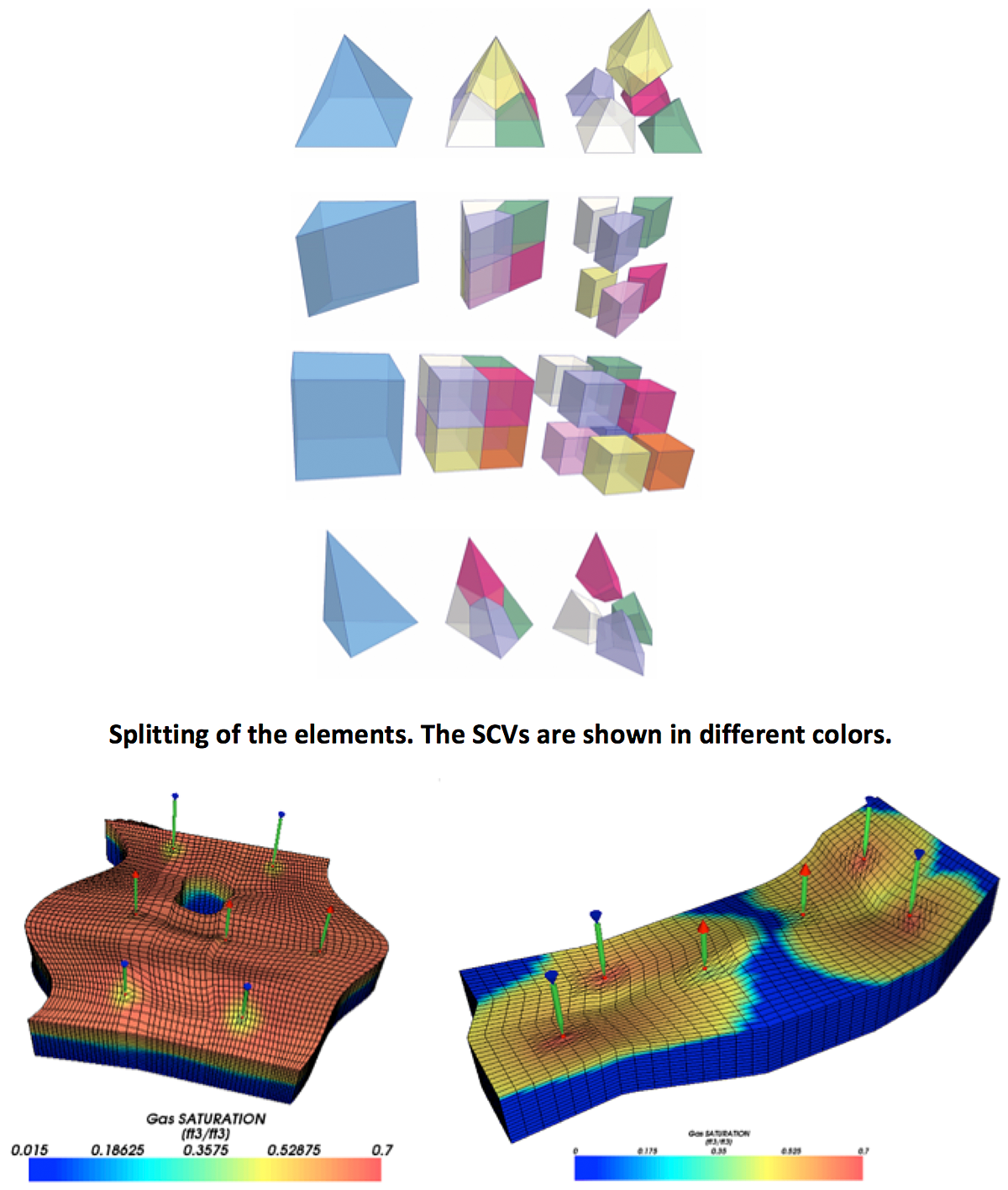
Wettability Alteration
Laboratory surfactant/alkali and hot water floods have shown great potential in increasing oil recovery for reservoirs that are naturally fractured and have low permeability and mixed-wet matrix rocks. The mechanisms for oil recovery are the combined effects of reduced interfacial tension, reduced mobility ratio, and wettability alteration. These processes have not been tested on either pilot- or field-scale mainly due to lack of complete understanding of the complex mechanisms involved. Surfactants have been used to change the wettability with the goal of increasing the oil recovery by increased imbibition of the water into the matrix rocks. Reservoir simulation is required to scale-up the process from laboratory to field conditions and to understand and interpret reservoir data.
Our goal is to model surfactant spontaneous imbibition experiments in carbonate cores to better understand and predict the oil recovery mechanisms as a function of wettability, to develop scale-up methodology, and to aid in development of a correlation for degree of wettability alteration. These simulations are performed using either explicit fractures or the multiphase, multicomponent dual porosity model in UTCHEM.
Wettability Alteration In Fractured Carbonate Reservoirs
Oil recovery from fractured carbonate reservoirs by water flooding is often inefficient due to the commonly oil-wet nature of these rocks and the lack of sufficient spontaneous capillary imbibition driving force to push oil out from the matrix to the fracture network. Chemical processes such as surfactant/alkali-induced wettability alteration and interfacial tension (IFT) reduction have shown great potential to reduce the residual oil saturation in matrix blocks, leading to significant incremental oil recovery (IOR). However, the IOR response time is the most crucial decision factor in field projects. The magnitude and time efficiency of recovery depend on the degree of wettability alteration and IFT reduction, the nature and density of fracture network, and the dimensions of matrix blocks.
The available data from laboratory scale include 1) phase behavior and rheological data, 2) results of secondary and tertiary coreflood experiments for P, SP, and ASP floods under reservoir conditions, static imbibitions experiments, i.e. chemical retentions, pressure drop, and oil recovery. Therefore the proposed models need to be first validated against well controlled lab and pilot scale experiments to have reliable predictions of the full field implementations.
The measured oil recoveries were history-matched using either heterogeneous permeability distribution or explicit fracture models. The simulation models were then used to predict the recovery response times for larger cores. The controlled and systematic laboratory measurements for several core sizes helped in developing dimensionless scaling groups to aid in understanding the time dependence and upscaling of laboratory results to field-scale applications. The key objective in this project is to propose a predictive scaling group which includes all the physics related to chemical EOR processes (interfacial tension reduction and wettability change) and can predict recovery for larger scale complex field cases.


Sponsors
Aramco
Formosa Petrochemical Corporation
MITRE
Rock Flow Dynamics
SimTech LLC
Strait Energy


